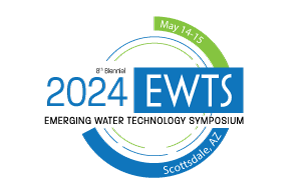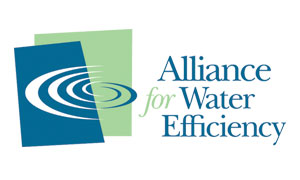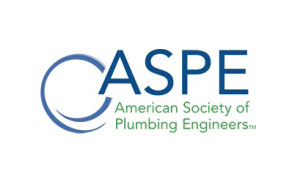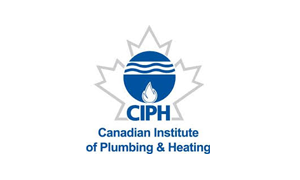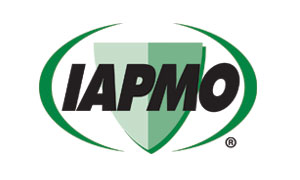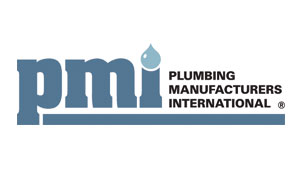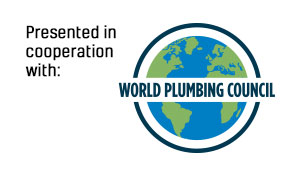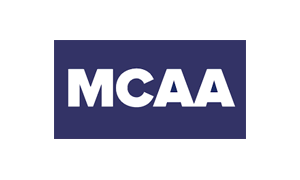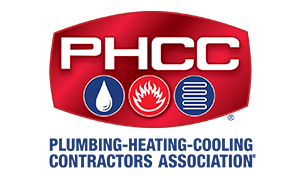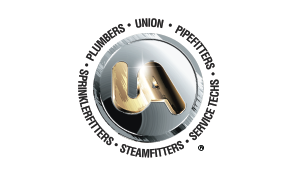5th EWTS
Rosemont, Illinois
May 10-11, 2016
Featured topics:
Opportunistic Pathogens in Premise Plumbing: The prime directive of the plumbing industry is to design and install safe water supply and sanitary systems for our nation’s buildings. However, water scarcity resulting from persistent drought and declining water quality are causing problems that the plumbing trade, plumbing engineers, building and facility managers, health officials, and even the public-at-large need to be aware of in order to mitigate the potential for opportunistic pathogens to thrive in premise plumbing and infect at-risk building occupants.
While it may seem that the issues of drought and the increase in legionellosis outbreaks are unrelated, they are in fact directly linked. The 2016 IETS took participants on a deep dive into this issue with podium presentations and a vibrant panel discussion.
Dr. Marc Edwards, engineering professor and researcher at Virginia Tech, Tim Keane, consulting engineer, principal, Legionella Risk Management, Inc. and Gary Klein, president, Gary Klein and Associates, Inc. were key speakers. These experts discussed how good design and engineering can provide cost effective and simple solutions for without creating conflicting unintended consequences. These excellent presentations were followed by a panel discussion that focused on proven mitigating strategies, determining where we are regarding needed research on opportunistic pathogens and examines the potential for the newly published standard ASHRAE 188P to reduce the trend of increasing outbreaks of legionellosis. The Plumbing Industry’s Research on Peak Demand for Residential Buildings: Dr. Steven Buchberger of the University of Cincinnati provided an update on the ASPE/IAPMO/WQA’s peak demand study, which has the potential to arrive at a new statistical process for water supply pipe sizing in residential buildings. The Keynote Address was presented by Sustainability Research Expert Professor Stuart White. Professor White is the Director of the Institute for Sustainable Futures leading a team of researchers dedicated to creating a path to a sustainable future through independent, project-based research. An acclaimed author, commentator and award honoree with over 30 years of experience in sustainability research, Professor White’s work focuses on achieving sustainability outcomes for a range of government, industry and community clients across Australia and internationally. Attendees learned what’s new regarding the topics that have made the IETS one of the most important and informative industry events: new and exciting technologies in the field of alternate water use technologies, plumbing fixture and fitting technologies, new water metrics for non-residential buildings, the water-energy nexus, and market based programs designed to foster the more efficient use of water in buildings.
Keynote: The Role of Innovation in Urban Water Futures – Bring On the Next Generation | Professor Stuart White, Director of the Institute for Sustainable Futures
His team of researchers are dedicated to creating a path to a sustainable future through independent, project-based research. An acclaimed author, commentator and award honoree with over 30 years of experience in sustainability research, Professor White’s work focuses on achieving sustainability outcomes for a range of government, industry and community clients across Australia and internationally.
Innovation in Urban Onsite Water Reuse | Paula Kehoe of S.F. Water
With water supplies increasingly strained, communities are looking for new ways to develop and manage local water resources. One of the most exciting paradigm shifts in sustainable water management is the integration of smaller, decentralized onsite systems that treat and reuse water within buildings. While cities have begun to deploy on-site water programs to treat and reuse water for irrigation, toilet flushing, and cooling, scaling of these systems has been stymied due to a number of institutional and regulatory barriers.
Several years ago, the San Francisco Public Utilities Commission (SFPUC) integrated on-site water reuse when they constructed their new headquarters building—resulting in a 65% reduction in water reuse. Based on this success, citywide policy was passed, sparking a number of commercial and mixed-use buildings to also integrate onsite water reuse. Currently, the SFPUC is leading a national effort to develop public health guidelines that can be adopted by state agencies or local officials to support the adoption of onsite water systems.
This presentation will discuss the work underway and the next steps in the coming year.
Achieving Zero Net Water | Dr. Markus J. Lenger, CEO, CSO and Co-Founder, CleanBlu & Eric Bowler, Senior Sustainability Engineer for Whirlpool Corporation
Application and lessons learned applying Net Zero water at the Reneww House at Purdue
One block from the campus of Purdue University, Indiana an eighty-seven year old home was converted into a world class research laboratory and sustainable living showcase, appropriately named ReNEWW (Retrofit Net zero Energy Water Waste) House www.renewwhouse.com. This new concept of a living research laboratory made headlines around the world culminating in a presentation during the COP21 2015 Paris Climate Conference. Sponsors Whirlpool Corporation and Kohler Company entrusted the world renowned water pioneer CleanBlu, California to design an entirely new generation of greywater processing systems. CleanBlu’s expertise of in-situ bioremediation of FOG (fats, oils & greases) from commercial kitchens influenced the conception of a greywater processing system effective enough to manage kitchen effluent, without the use of filters while continuously disinfecting the wastewater. In this case, as the state of Indiana has no need for irrigation, the processed water is used for toilet flushing and laundry. The treatment system was designed as an appliance that uses a primary aerobic biological stage and a secondary advanced ozonation stage for sterilization. The CleanBlu GPU (Greywater Processing Unit) represents a break through as an alternate water source technology using state-of-the-art equipment to control and manage water processing via IoT (Internet of Things) and a dedicated smartphone app with remote reporting.
Sustainable Water Reclaim Systems: Designing within Regulatory Challenges | Jonathan Gray, CPD, Principal, Interface Engineering
Many people believe water supply will be one of the major environmental and infrastructure issues of the next 50 years. Even in wet climates, it’s important to take steps now to cut building water use and to reuse as much water as possible, effectively closing the water cycle within the building itself. Mr. Gray’s presentation will discuss several water reclamation system case studies—including the technical and regulatory challenges and solutions. The presentation will illustrate how rainwater, greywater and blackwater harvesting and reuse can become a seamless part of a building’s integrated design. Typically, we have been able to incorporate these water reclaim systems into building design only after appealing local and state plumbing code. As water reclaim systems become more and more prevalent in building design, changes to state and national plumbing codes are being made, therefore eliminating the need for appeals. As a former Oregon State Plumbing Chair and Board member, Mr. Gray will provide first-hand experience in the appeal process, changing/developing codes, and insight into the rulings that affect the present plumbing code in Oregon.
Focused on the benefits of water conservation, Mr. Gray’s presentation will interest any professionals interested in sustainable design in the built environment. Participants will leave the event with a greater understanding of water harvesting reuse concepts and strategies, understand the integrated design process, and how a water conservation fits within a building’s whole water system.
Designing innovative water systems is an increasingly necessary practice for resource conservation. Regulations are transforming barriers to drivers as green rating systems encourage reuse through rainwater harvesting, stormwater management, and on-site wastewater filtration. Jon’s presentation will provide insight to revised water policies, state-of-the-art treatment systems, and the future of water-independent buildings.
Objectives
• Understand regulatory limitations and drivers of whole water systems design.
• Explore the regulatory challenges and obstacles to overcome
• Introduce tools used in estimating water usage and rainwater harvesting
• Explore systems and precedents of combining rainwater harvesting, stormwater management, wastewater filtration, and water reuse.
• Identify opportunities for integrating these elements into the landscape at varying scales as educational amenities.
Maximum Cooling Tower Water Conservation | Shawn Bray, Cooling Tower Water Conservation Educator, Terlyn Industries
Describe the importance of water conservation in cooling towers and the impact of implementing a tested and proven cooling tower water conservation program including case studies with Denver Water and privately owned and operated commercial buildings.
Present validated data to encourage building owners, facility managers, and community leaders to implement a cooling tower water conservation program, proven to maintain complete system integrity (no scale, no corrosion, no biological growth) and reduced cooling tower water waste from nearly 50%, in some cases, down to only 2-3%.
This emerging technology will pave the way for more buildings to save rivers of water throughout the United States and beyond.
Let’s Get W.E.T. Together in Vegas!The Southern Nevada Water Authority’s Water Efficient Technologies Program | Kent Sovocool, Senior Conservation Research Analyst, Southern Nevada Water Authority (SNWA)
This presentation covered one of the nation’s largest commercial/industrial technology focused water efficiency rebate programs. The talk covered the history of the program, its current structure and its successes, and some special areas of emphasis.
The audience learned of the existence of this program and explain its dual menu and custom track option. Vendors and representatives of technologies will realize the additional marketing opportunities afforded by the program to the targeted customer classes which are incentivized and most importantly other utilities will see a model of how such a program is successfully implemented and what it can accomplish.
“First – Do No Harm” – Hippocratic Oath | Bill Gauley, P.Eng., Principal, Gauley Associates Ltd.
Codes and Standards are developed with the intention of helping ensure public health and safety. We absolutely NEED Codes and Standards! However, many of the Codes and Standards we rely on to design our municipal and in-building water delivery systems were developed 100 years ago. While good design practices typically involve “erring on the side of caution”, there is a significant difference between being cautious and shamelessly over designing. If our water design engineers had worked for NASA in the 1960s the Apollo rockets would have been far too over-built and heavy to get into space. Our plumbing fixtures and appliances use much less water than they used to even a decade or two ago; per capita demands have plummeted to such a degree that many water agencies are experiencing revenue shortfalls; millions of gallons are wasted because water mains need to be flushed to maintain water quality; there are concerns that declining water demands may lead to ‘dry’ drain lines and sewers. Water efficiency is not going away – no one is promoting the use of more water to help bolster revenues or to help move waste through the sewer pipes – and, in fact, demands are almost certainly going to continue to decline for several more years. This presentation will look at how some possible ‘disruptive changes’ in the way we design our water and wastewater systems – both under the road and in our buildings – could help facilitate a greater efficiency.
Estimating Peak Water Demands in Buildings with Efficient Fixtures – Highlights and Extensions from the 2015 ASPE/IAPMO/WQA Study | Steven Buchberger, College of Engineering and Applied Science, University of Cincinnati
An IAPMO / ASPE / WQA task group recently completed a draft report on estimating peak water demands in residential buildings fitted with efficient fixtures. The draft report proposes a new probability-based method similar in principle to Hunter’s Curve for determining peak water demands. The new method replaces fixture units with probability of fixture use. The fixture use probabilities are estimated from a large national data base of residential water use. The new procedure for estimating peak demands can be formulated as a universal dimensionless design expression that is easily programmed on an excel spreadsheet. An example will illustrate application of the new method at a single family residence and at a large office complex.
Toilets, Turbulence and Public Health | Dr. Michael Gormley, Institute for Building and Urban Design, The School of the Built Environment, Heriot-Watt University, Scotland
The building drainage system is not only a means of conveying waste away from a building as safely and as efficiently as possible, it is one of the main ways in which we maintain good public health. Fixture trap seals provide much of this protection, however they are vulnerable to phenomena such as evaporation and air pressure fluctuations, and can be compromised to the extent where no seal exists. The consequences can be severe, as evidenced by the link between infection spread and defective trap seals during the 2002/2003 SARS outbreak in South East Asia.
While defective water traps provide potential routes for infection spread, innovative sonar-like techniques allow the seal of an entire system to be monitored in seconds. This technique, developed at Heriot-Watt University, was validated in a number of ‘live’ buildings, including a complex hospital building. This technique is now well understood – the potential for cross contamination due to pathogen-laden bio-aerosols is less so. Current research using drainage flows from water dosed with Escherichia coli and Pseudomonas spp. – tracks the transmission of pathogens on naturally occurring and mechanically induced air currents, under defective water seal conditions. Previous relevant research investigated Norovirus in hospital building drainage using DNA techniques (RT-PCR) and is reported here also. Taken together, this research represents the cutting-edge of public health engineering, combining innovative engineering solutions with microbiology and fluid mechanics to more fully understand potential hazards to human health in our built environment.
Water Metrics for the Non-Residential Water Users: Using Real Data to Tell You How to Target the Institutional, Commercial and Industrial (ICI) Water Users | H.W. (Bill) Hoffman, P.E., President: H.W. (Bill) Hoffman & Associates, LLC
If you don’t measure it, you can manage it is an old but true statement. Using raw water use data to target sectors, benchmark commercial and institutional users, examine industrial water use and look at water use from a state wide perspective all involve the development and assessment of water use metrics.
Over the past few years, much progress has been made to quantify water use in the ICI sectors. The purpose of this presentation is to update the water community on the development of new metrics for how water is used in the ICI sectors, and how this information can be used target these sectors and develop effective conservation efforts.
1. A look at how much water is used in the ICI sector nationally;
What Texas found when they began requiring that utilities provide volumetric data by type of end user including ICI users;
A summary of benchmarking efforts nationally and internationally;
Examples of what benchmarking data says and how it can be used to target ICI water conservation programs;
Beyond benchmarking, how water is actually used by ICI end users; and
2. Where we may go in the future with such technologies as AMI.
Uber plumbing technologies from down-under | Jeff Patchell, Publisher, Connection Magazines Pty Ltd – Australia
The ancient Romans certainly understood the importance of distributed potable water and drainage – it was vital to the health of all citizens. But until Joseph Bazalgette designed an epidemic-avoiding sewer network in the mid-1800s, people barely gave plumbing a second thought.
Back then, as is the case today, plumbing had the power to save lives and advance societies; however, technological advances in this market are more incremental than of the market-disruptive nature that today’s crowd-funded start-ups use to command media attention.
There are many technological champions in the plumbing sector the world over and this presentation demonstrates some of the best examples from Australia and New Zealand.
These emerging technologies highlight smart new ways to install plumbing equipment that save time and money, as well as solutions that address the needs of our rapidly ageing society and the associated loss of technical and skill knowledge across the industry.
Typically, Australia punches above its weight when it comes to entrepreneurial thinking and ideas (and sport!); delegates to the 2016 Emerging Technology Symposium will learn of some exciting new problem solving ideas they can take back to their own businesses and organizations.
Creating a Market Value for Water Efficiency in Residential Buildings – The RESNET/International Code Council Water Efficiency Rating Index ANSI Standard | Steve Baden, RESNET Executive Director and Mark Johnson, International Code Council (ICC) Executive Vice President & Director of Business Development
RESNET and the ICC is developing the first national consensus standard for the rating and labeling of a home’s water efficiency performance. This session will explain the RESNET/ICC Water Efficiency Rating Index and its implications in creating a market based effort to reward builders for constructing water efficient homes.
Presentation objectives:
• Explain the new Water Efficiency Rating Index
• Explore how water efficiency can be tied into residential energy efficiency
• Explore how proper market signals can lead to homes that waste less water
In many parts of the nation water is fast becoming an increasingly limited and expensive commodity. There is clearly a need for a system to rate a home’s water use efficiency. This will allow homebuyers to know how efficiently water is being used in the homes they are considering. It will also provide an opportunity for homebuilders to monetize the efficiency of their homes in the same fashion that the RESNET HERS Index does for energy efficiency.
RESNET and the International Code Council (ICC) are developing an ANSI national consensus standard for a Water Efficiency Rating Index (WER Index). The standard is being developed by a coalition of water efficiency experts, homebuilders, environmental organizations and home energy professionals.
The WER Index will be numeric score based upon the home’s water efficiency. A numeric score will help homebuyers understand the water efficiency of a house the same way car shoppers use fuel efficiency labels to inform their purchase decisions. The score will help expand green building programs and encourage new rebates and tax incentives for water efficiency products in new and existing homes. Consumers who “know the score” will save water and money when they buy a home or renovate an existing home. This session will explain the RESNET/ICC Water Efficiency Rating Index and its implications in creating a market based effort to reward builders for constructing water efficient homes.
For more information on the WER Index click here
Hot Water System Technologies and Research Update | Panel Discussion: Gary Klein, President, Gary Klein and Associates; J. Joe Scott, CPD, FASPE, Vice President and Senior Plumbing Designer for Cannon Design; Jerry Calahan, CEO, Heatworks; David Epstein, President, Orbital Systems
How to achieve the best efficiencies in hot water system design has been a controversial topic in the plumbing industry for many years. On day 1 of the IETS, hear what our panel of experts have to share on the latest technologies and research regarding this dynamic and quickly evolving topic. Our panelists will also address future research needs that will work towards furthering the industry’s desire to utilize the most efficient and practical systems available.
Advancing Energy Efficiency in Urban Water Systems | Lorraine White – GEI Consultants
Technologies continue to advance however certain markets are slow to adopt these new and innovative devices and applications. The National Electrical Manufacturers Association (NEMA) selected GEI Consultants, Inc. (GEI) and its partners (the Alliance for Water Efficiency and M.Cubed Inc.) to assess and identify new strategies and approaches to support the advancement of energy efficiency in Urban Water Systems. To accomplish this, GEI is engaging industry and water agency representatives through interviews and surveys. Responses will be analyzed along with available market data and the results of recent studies to determine the extent of the current market penetration and the potential for further adoption. GEI’s team is also evaluating the viability of energy savings performance contract practices, other financing mechanisms and government grants to finance modernization system upgrades. Results will inform future collaborations between manufacturers and water agencies and the development of plans with measureable outcomes that advance the energy efficiency of Urban Water Systems.
Water Policy and New Technology: Examining the Connection | Mary Ann Dickinson, President and CEO, Alliance for Water Efficiency
New technology can only be successfully deployed to solve water resource problems if the existing policy and market barriers are removed to enable that deployment. Historically, new innovations have been trapped in a “valley of death” where patents are issued, but years go by before any market uptake of the product. Energy programs have been initiated at the federal and state levels to deal with this problem and jump start energy technology, thus avoiding this “valley of death” phenomenon so prevalent in water. Solar, wind, biogas, and other renewable energy sources and technologies are heavily incentivized at the federal and state levees, both in policy enablement and funding.
Not so in water. No significant federal or state programs exist to promote uptake of new water technologies. But that might be changing. For the first time in decades, the White House is taking notice. On December 15, 2015, the administration convened a White House Summit on Water Innovation to examine how to better move forward new water technologies in a roundtable setting. A white paper was issued shortly thereafter discussing the problem. This presentation will outline what was discussed at the roundtable that day, what the report recommends, and why.
WaterSense – The Next Decade |Stephanie Tanner, Lead Engineer, U.S. Environmental Protection Agency’s WaterSense and Robert Pickering, Environmental Engineer, Eastern Research Group Inc.
With 10 years under its belt and with the help of over 1,700 partners, WaterSense has labeled 16,500 models of products across seven categories. This effort to shift the market towards water-efficiency has helped save more than 1.1 trillion gallons of water. So what is in store for the next 10 years? For starters, some states and localities are adopting increasingly stringent efficiency requirements for many of the product categories that WaterSense labels. WaterSense is evaluating those initiatives and the feasibility of new specification levels that offer higher efficiency and performance. WaterSense will also be introducing several new irrigation and plumbing products to its pipeline this year. While driving efficiency is a primary mission of the program, Ms. Tanner will discuss the challenges we face in those efforts. You will hear about how WaterSense is working with stakeholders to evaluate and understand plumbing system performance, health and safety impacts and constraints associated with further reducing fixture and fitting flow rates. Finally, while the program has enjoyed success from its product labeling efforts to date, there are tremendous opportunities to improve the efficiency of whole buildings and complex water using systems, such as cooling towers. Buildings and systems, however, are very dynamic and water use and efficiency depend on a variety of factors including the initial design, efficiency of the components, and operation and maintenance. Ms. Tanner will discuss the programs preliminary thinking on how it could expand its focus into new areas as it approaches its second decade.
Onsite Sanitation for the Developing World: Challenges and Insights | Rob Zimmerman, Kohler Co.
Kohler Co. has been working closely with the California Institute of Technology (Caltech) and the Bill & Melinda Gates Foundation to understand the challenges and opportunities of commercializing systems to rapidly treat sanitary waste onsite. Once developed, this technology could facilitate new ways to reduce human exposure to fecal pathogens in places where adequate water and sewer infrastructure does not exist, such as rapidly developing countries in Africa and South Asia. This presentation will provide an update on the technology, experimental design, and ongoing field trials.
Chemistry 101-Behind the Wall Considerations and Solutions for Reduced Water Consumption Rates of Urinal Fixtures | Daniel Gleiberman, Manager Product Compliance and Government Affairs, Sloan Valve Company
Reduced consumption and zero consumption rates for urinal fixtures have distinct and potentially profound effects on the sanitary piping and drain line carry, due in large part to chemistry. This presentation will provide an overview of the various chemical processes at work and explore best practices and new technologies to address these effects. Presentation objectives: Provide a comprehensive technical and literature review of what really happens behind the wall in pipes for all types of urinals, and offer lessons learned and new technology solutions. While manufacturers have responded to the need for lower water consumption with superior and better-performing products such as ultra-high-efficiency water and nonwater urinals, the impact on existing plumbing drainage systems with greatly reduced volumes remains a concern. This presentation will review all studies that cover this topic and also provide clear actions that plumbers, engineers and building maintenance personnel can take to maximize the performance of these fixtures and minimize issues. Presentation will also provide a comprehensive overview of new technologies and best practices for sustained water efficiency and system performance.
Premise plumbing decontamination: Research and technology needs | Andrew J. Whelton, Ph.D., Purdue University, Lyles School of Civil Engineering and Division of Environmental and Ecological Engineering
In the wake of numerous large-scale drinking water chemical contamination incidents since 2014, it has become clear that the water and public health sectors do not understand premise plumbing water quality, materials, its design, or how to decontaminate [decon] premise plumbing safely. Since 2014, more than 100,000 drinking water premise plumbing systems that served more than 1.5 million people have become chemically contaminated. Once contamination was detected, water companies and government agencies have ordered building inhabitants to avoid their drinking water out of safety concerns. Consequences of plumbing system contamination have resulted in loss of public confidence in government officials, water providers, economic damage to local and regional economies, and personal hardships of the affected population. Contaminants that have contaminated premise plumbing in the past two years alone have included coal washing agents, oils and fuels, algal toxins, heavy metals, among others. Buildings affected include residences, commercial buildings, as well as other structures.
In an effort to protect public health and minimize the economic damage caused by the loss of premise plumbing functionality, water utilities and government agencies have directed building inhabitants to follow their prescribed plumbing decontamination guidance. On numerous occasions however, some building inhabitants experienced acute side-effects due to chemical exposure [i.e., dizziness, nausea, skin irritation], actions caused greater levels of chemicals at their faucets than before flushing guidance, and water testing data showed that plumbing decontamination procedures did not result in water heaters being safe for use. Moreover, chemicals sometimes sorbed and desorbed to pipes contaminating clean drinking water unbeknownst to flushing guidance developers and waste disposal consequences were not considered. The academic, water and public health sectors would benefit from partnerships with the plumbing and technology innovation industries to address these emerging problems.
This presentation will describe recent drinking water contamination incidents, plumbing decontamination testing results from Purdue University’s pilot-scale facility, field plumbing system decon activities, as well as bench-scale tests involving various materials and decon strategies. The audience will gain a better understanding with regard to the state-of-the-knowledge for rapid and safe premise plumbing decon.
Learning objectives are to:
• Describe common approaches used to decontaminate premise plumbing that has become chemically contaminated
• Identify premise plumbing components that require additional attention to clean
• Explain health risk and waste management challenges specific to plumbing decontamination
• Detail opportunities for research and technology development
Common Mistakes in Managing Legionella in Large Buildings | Janet E. Stout, PhD, Special Pathogens Laboratory
Cases of Legionnaires’ disease have increased dramatically. The causes of this increase will be discussed as well as recent reports on the presence of Legionella in municipal distribution systems and the status of prevention guidelines and standards. “Experience is the name everyone gives to their mistakes.” This presentation will provide you with critical information to control Legionella in building water systems and avoid costly mistakes. A proactive approach, environmental monitoring and a water safety plan is the key to ending Legionnaires’ disease. While development of a Water Management Plan per the new ASHRAE 188 standard is a good start to prevention, the standard has critical gaps. Specific knowledge of Legionella with building water systems is needed. This includes knowledge of the appropriate use of Legionella monitoring and its role in prevention. Despite its importance in prevention strategies, there is a lack of standardization of environmental sampling and testing for Legionella spp. Culture remains the “gold standard” used for detecting Legionella; however numerous “rapid” methods are being used. New information will be reviewed on molecular methods including possible limitations in risk assessments and water safety plans.
Objectives include:
• Understand the challenges of Legionnaires’ disease prevention and control of Legionella in premise water systems.
• Understand critical gaps in ASHRAE 188 and their implications for liability and successful Legionella control.
• Learn “what’s new” in Legionella control and disinfection methods.
• Understand the role of Legionella testing in disease prevention and risk management
Water Quality, Water Savings and Water-Energy Nexus – Three Issues, One Solution? | Tim Keane, Consulting Engineer, Principal, Legionella Risk Management, Inc.; Gary Klein, President, Gary Klein and Associates, Inc.; Dr. Marc Edwards, Professor, Virginia Tech
Unintended consequences is a common expression. In plumbing equipment, designs and codes there are many examples of unintended consequences. Low temperatures for energy and scald concerns, tepid water for eye wash stations and safety showers, low flow for water conservation all can significantly increase the risk for Legionella colonization.
Many think these three areas; scald protection, energy conservation and Legionella control pose inherent, unsolvable conflicts in building water system design and operation. One of the presenters refers to the LEED acronym as often resulting in Legionella Enabled Engineering Design.
This program presented a 90 minute review of case histories, and studies by field and academic experts discussing specific examples of plumbing components and design. Tim Keane has investigated Legionnaires’ disease outbreaks across the country and written papers and made presentations on issues related to Legionella investigations, mitigations and plumbing systems design to minimize risk. Gary Klein is a hot water system expert that has done extensive research and field studies in building hot water system design related to energy, conservation and code issues. Marc Edwards, an engineering professor and leader of a team of researchers at VT has studied all aspects of potable water including treatment methodologies, corrosion impact, and waterborne pathogens. He recently has been heavily involved in studies of Flint water and related Lead and Legionella issues.
These experts will review the selected designs and components from their areas of expertise and show how in fact good engineering can provide cost effective and simple solutions without conflicting unintended consequences to the issues of Legionella, Scald prevention, Energy and water conservation.
Mitigating Opportunistic Pathogen Outbreaks from Water in Premise Plumbing Systems | Panel Discussion: Dr. Mark Edwards, Virginia Tech University; Dr. Jamie Bartram, The Water Institute at the University of North Carolina; Dr. Janet Stout, Special Pathogens Laboratory; Tim Keane, Consulting Engineer, Principal Legionella Risk Management; Gary Klein, President, Gary Klein and Associates; Dr. Andrew Whelton, Associate Professor, Purdue University
The 2016 IETS concluded on day 2 with a compelling panel discussion on mitigating opportunistic pathogen breakouts from water in premise plumbing systems. The IETS assembled some of the most knowledgeable experts on plumbing design and effective treatment strategies that helped inform attendees regarding the latest research and information on this critically important topic. The panel discussed the implications surrounding the publication of ASHRAE standard 188-P, Legionellosis: Risk Management for Building Water Systems.
